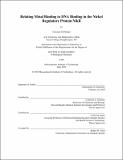Relating metal binding to DNA binding in the nickel regulatory protein NikR
Author(s)
Phillips, Christine M. (Christine Marie)
DownloadFull printable version (46.67Mb)
Alternative title
Relating metal binding to deoxyribonucleic acid binding in the Ni regulatory protein NikR
Other Contributors
Massachusetts Institute of Technology. Dept. of Chemistry.
Advisor
Catherine L. Drennan and Collin M. Stultz.
Terms of use
Metadata
Show full item recordAbstract
The concentration of transition metals within the cell must be tightly regulated. If the concentration of a given transition metal is too low the cell may not be able to perform life-sustaining processes, while high levels of metals are poisonous to the cell and can cause cell death. In Escherichia coli, NikR regulates nickel uptake by blocking transcription of the genes encoding the nickel uptake transporter, NikABCDE. NikR is a homotetrameric transcription factor with a central metal binding domain (MBD) that includes the tetrameric interface and two flanking dimeric ribbon-helix-helix (RHH) DNA-binding domains. Early work revealed that NikR can bind a variety of transition metal ions and has two binding affinities for the nik operon: nM when stoichiometric Ni2+ binds NikR and pM when excess Ni2+ binds. The enhanced DNA affinity suggests the presence of low affinity nickel binding sites on the protein. Recently, it has been shown that NikR also requires K+ to bind DNA, suggesting yet another type of metal binding site on the protein. To understand NikR's ability to bind multiple transition metal ions and how Ni2+ specifically induces NikR-DNA binding, we solved the crystal structures of the apo- MBD and BMD bound to Zn2+ and Cu2+. Comparing these structures to the previously published Ni2+-MBD structure, we noted that when the proper metal binds to NikR it utilizes H76 of alpha helix 3 as a ligand. This, in turn, orders helix !3, and we propose this conformational stabilization is a key step in the NikR-DNA binding mechanism. Electrostatic free energy calculations and thermodynamic integration were used to study which metal prefers to bind at a site between the MBD and RHH domains that is formed when NikR is bound to DNA. Our studies illustrate that NikR-DNA binding was most favorable when this site contains a monovalent cation the size of K+. These studies support a physiological role of K+ in NikR-DNA binding. Structures from crystals of NikR and NikR-bound to DNA soaked with excess nickel ions indicate six types of potential low-affinity nickel binding sites on the protein surface. Binding of excess nickel ions to these sites does not induce any significant conformational change, suggesting that these sites have an electrostatic effect increasing ! 4 NikR's affinity for DNA. Using a combination of X-ray crystallography and molecular simulations we have identified and explored the metal binding sites on E. coli NikR and how they influence NikR:DNA binding.
Description
Thesis (Ph. D.)--Massachusetts Institute of Technology, Dept. of Chemistry, 2010. This electronic version was submitted by the student author. The certified thesis is available in the Institute Archives and Special Collections. Vita. Cataloged from student-submitted PDF version of thesis. Includes bibliographical references.
Date issued
2010Department
Massachusetts Institute of Technology. Department of ChemistryPublisher
Massachusetts Institute of Technology
Keywords
Chemistry.